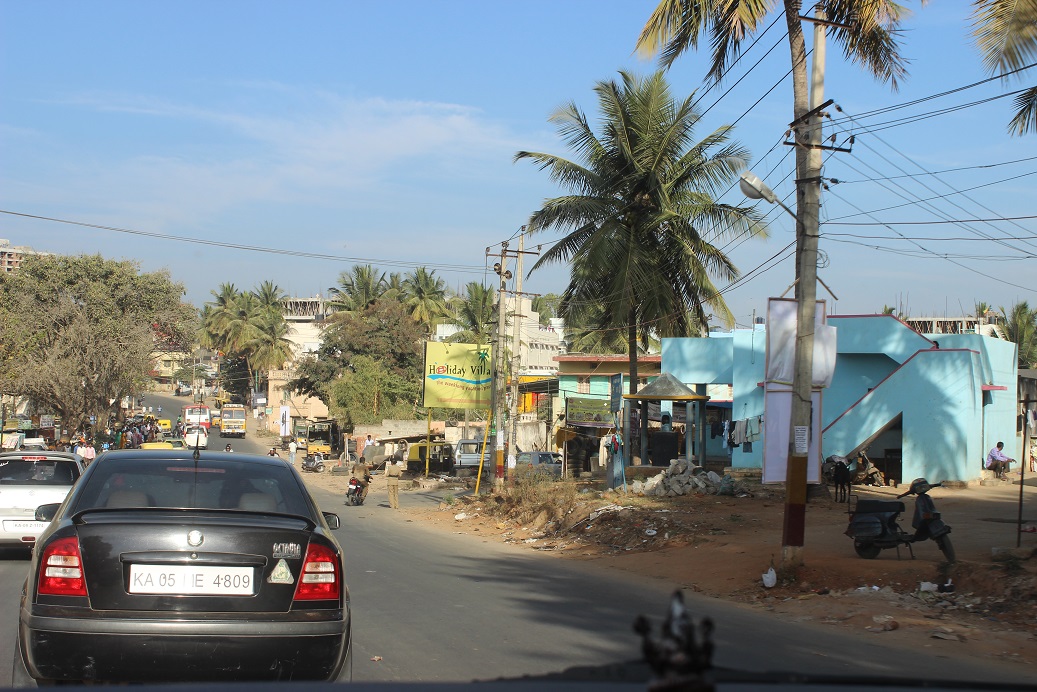
It was a beautiful morning as I left the hotel at about 7am. Today I am going to the Sri Sri Ayurveda Pañchakarma Center at the world-renown Art of Living International Center. It is about a 45 minute drive from my hotel and the city was already bustling.
As you know, I am an Ayurveda Consultant and love to come to this world renowned center when I am in Bangalore to experience and learn all I can about this ancient practice. Ayurveda is a holistic system of medicine and healing that has been practiced in India for over 5,000 years. Incorporated in the ancient Indian text, the Atharva Veda, the last of the Vedas, Ayurveda focuses on holistic wellness – the balance of the mind, body and spirit in rhythm and harmony with nature. The term Ayurveda comes from the Sanskrit term ‘Ayu’ meaning life and ‘Veda’ meaning knowledge. It translates into the ‘science of life’. Ayurveda is based on two fundamental theories, the Pancha Mahabhutas and Tridosha theory. Ayurvedic philosophy believes that everything in the universe is made of elements. When the Pancha Mahabhutas or five elements (space, air, fire, water, and earth) which make our being are balanced, the body is healthy and when they are imbalanced, there is disease. These elements manifest into life forces and make each of us unique, physically and mentally. The elements combine into three Doshas (Tridosha) (life forces) – Vata, Pitta and Kapha. The combination of the three Doshas influences our mental, emotional and physical tendencies. Ayurveda’s primary focus is on avoidance of illness by proactively leading a healthy way of life. It seeks to balance and restore health through wholesome food, exercise, meditation, relaxation and cleansing. Ayurveda as a science is holistic and nourishing.
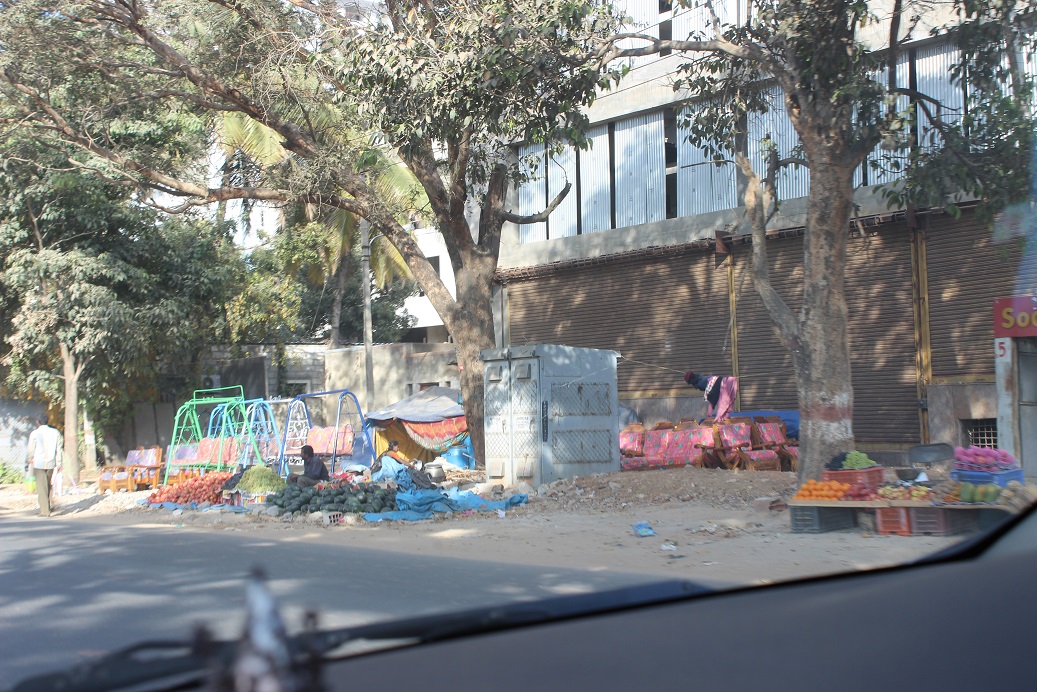
This morning drive takes us past fruit and vegetable vendors as well as swing and chair vendors were getting ready for a busy day!
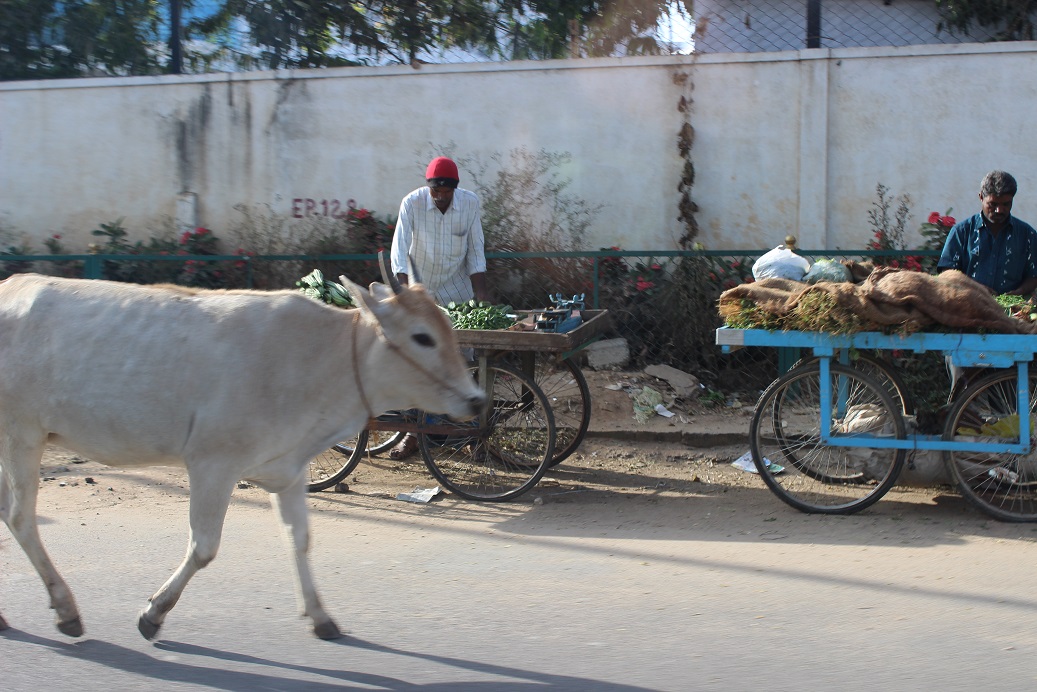
The cows were on their way to work, grazing and hanging out!
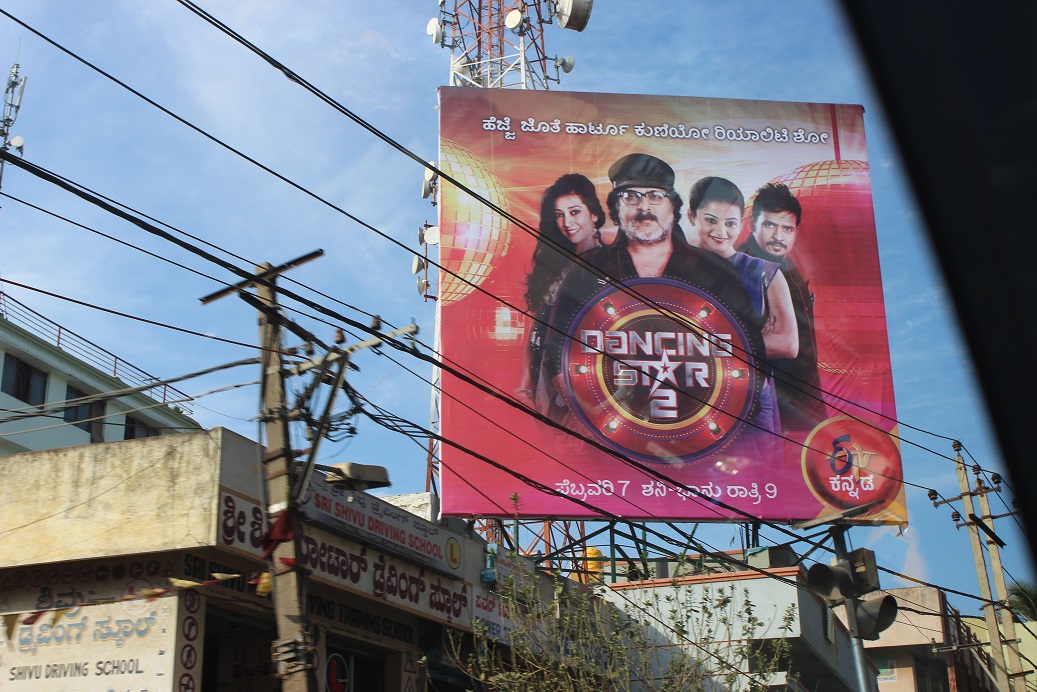
I can’t wait to watch Dancing with the Stars tonight!
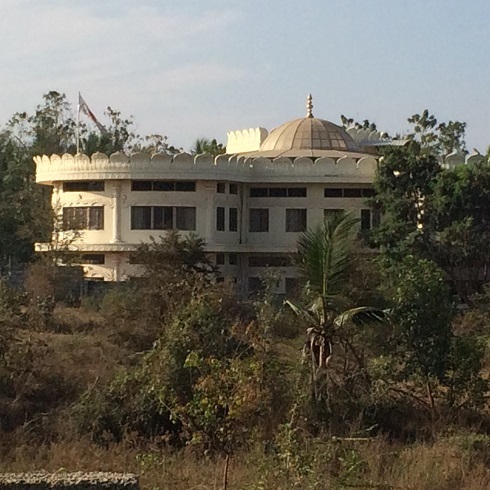
I knew we had arrived when I saw these distinctive buildings in the distance. Most of the main buildings on this Art of Living International Center campus have a similar “lotus” look. It took us a long time to find the correct entrance the last time I was here, so when my driver pulled into the wrong driveway, I told him to ask where the Pañchakarma Center parking was. Just up the hill and a couple of turns later there we were.
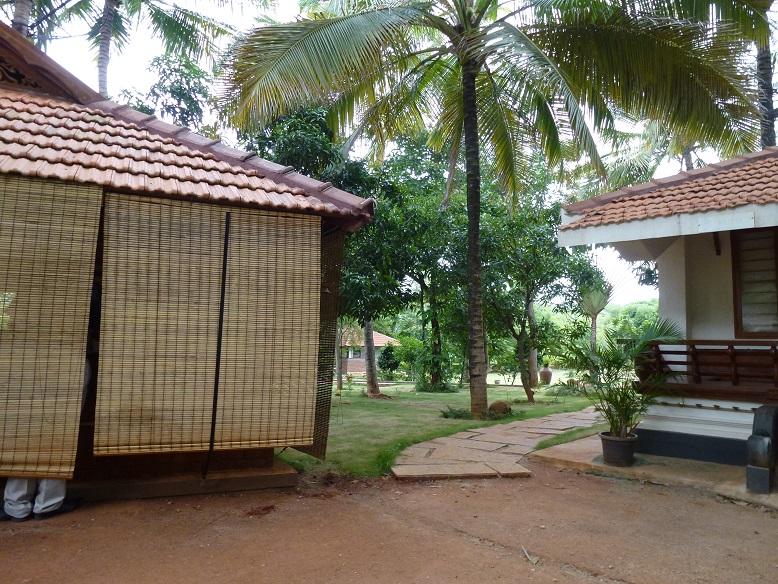
After parking the van, I made my way to check-in before having some breakfast.
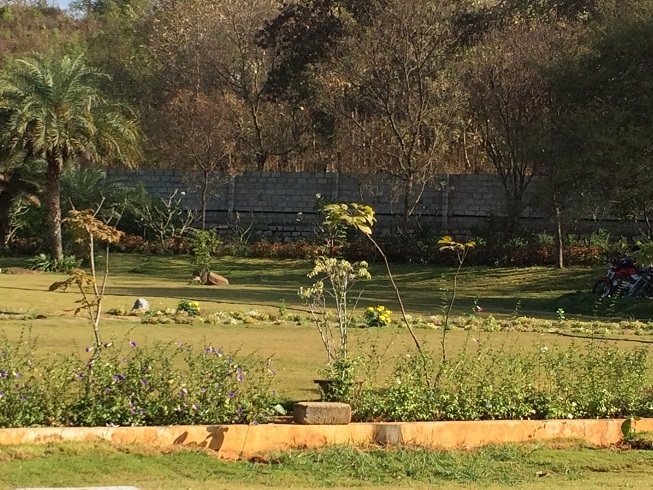
It is just a short walk to the dining hall through the main center of the campus. Sri Sri Ayurveda Pañchakarma is a wellness initiative with Ayurveda, the ancient Indian science of life as its intrinsic form of healing, cleansing, restoring and revitalizing the mind, body and spirit. Sri Sri Ayurveda Pañchakarma promotes a lifestyle that is in harmony with Nature. It offers therapies, treatments and beauty regimes rooted in ancient Ayurvedic traditions and a wide range of alternative healing and restorative therapies from around the world. It brings together a bouquet of holistic treatments bridging ancient traditions and contemporary needs and comforts.
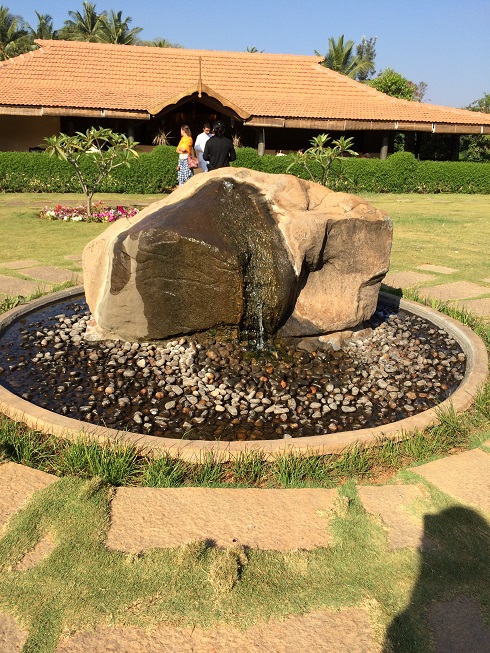
The building behind this little water fountain was the eatery. It is an open-aired building with little short tables and comfortable benches.
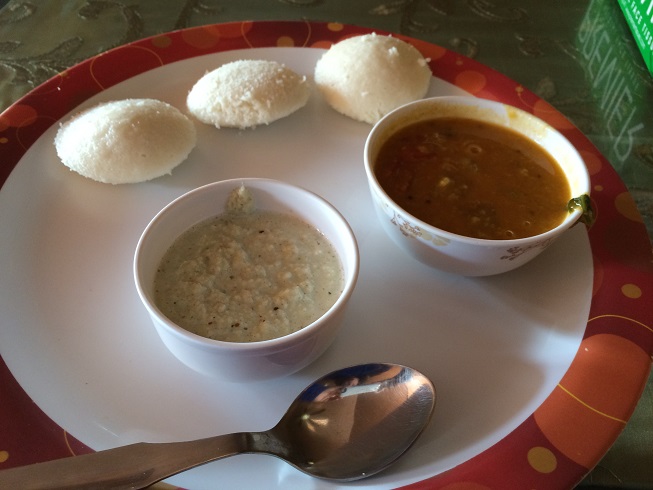
Breakfast doesn’t look like much, but it sure filled me up. It was a small cup of chickpea curry, appan (a sort of pancake) and a small cup of sweet oatmeal.
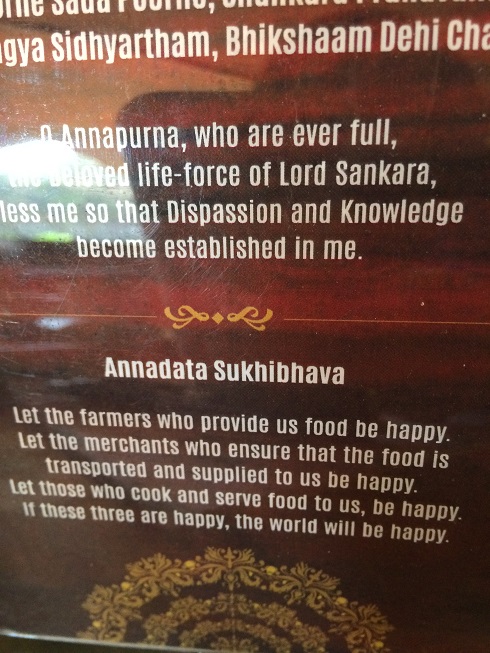
This was the small prayer that was sitting on the table. I thought it was sweet and wanted to keep it as a reminder to be grateful.
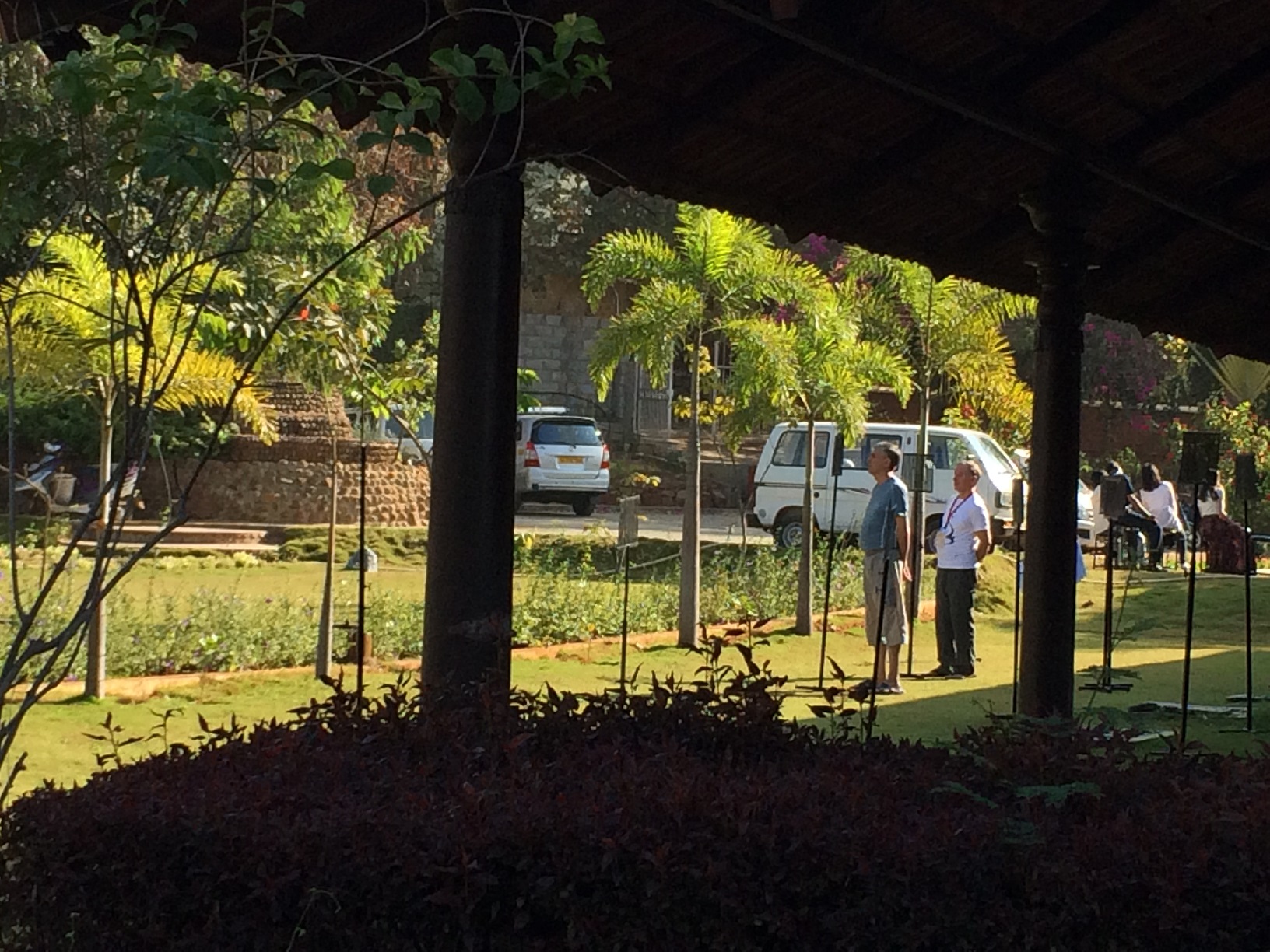
Here are some patients doing eye therapy. They stand behind metal poles with slits in them and then sway back and forth. Somehow this helps balance far and near-sightedness!
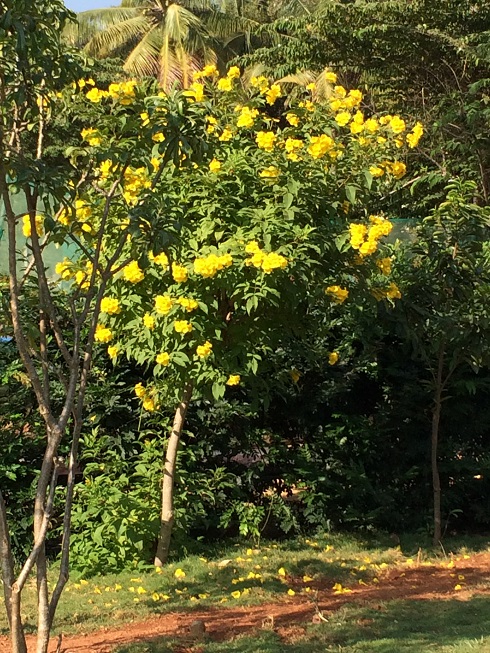
I had three hours until my first appointment so I decided to just take a walk. You definitely want all your food digested when you go for abhyanga.
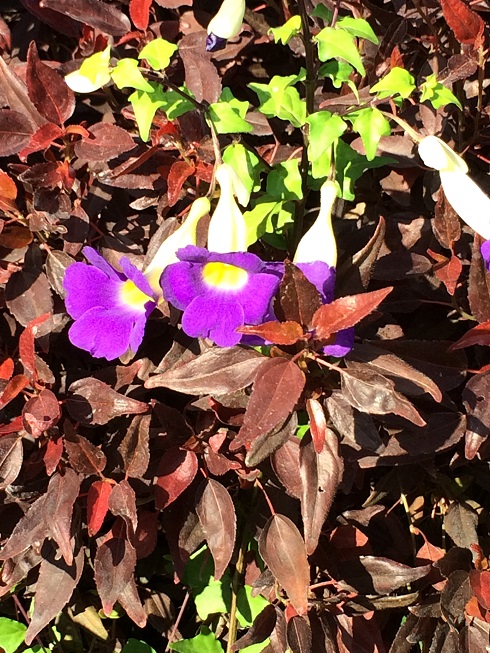
Many beautiful plants live here at the ashram.
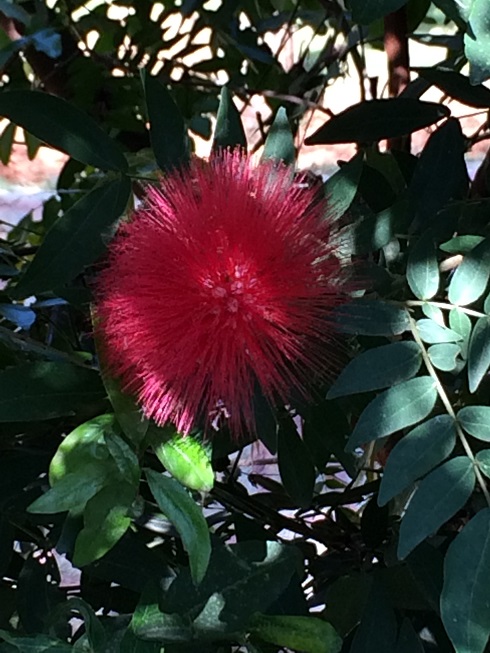
This pink puff was just brilliant.
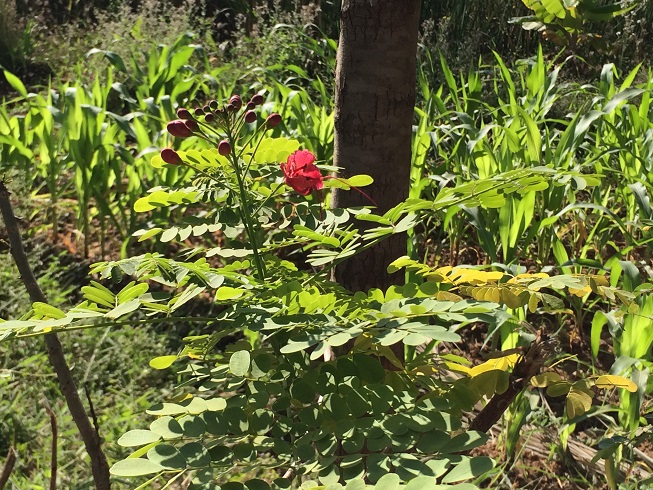
Not overly groomed, the grounds are well kept.
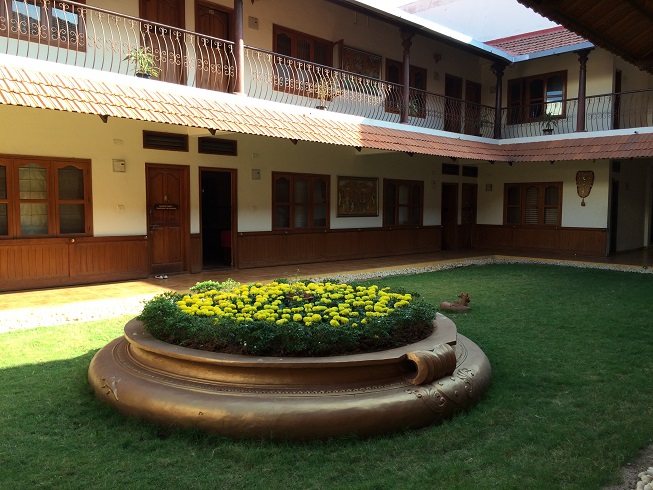
Almost time for my first treatment, I entered the courtyard of the treatment rooms on the way to the waiting room.
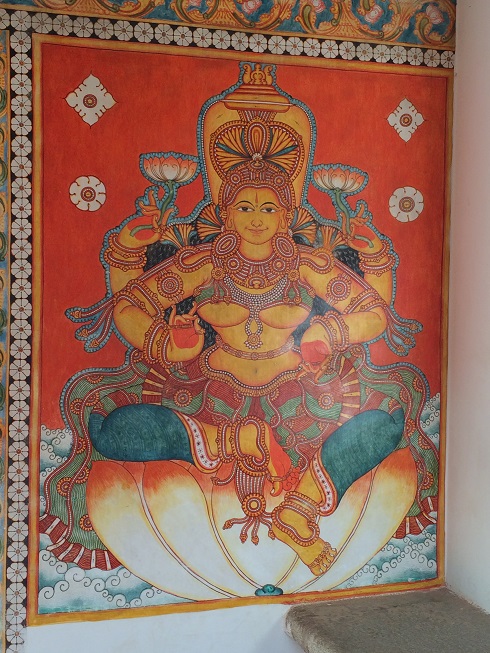
I just love these pictures on the walls of the waiting room. I wish I could have bought one and taken it home. These are of Dhanvantari, the god of Ayurveda medicine (read a little more about him later in the blog).
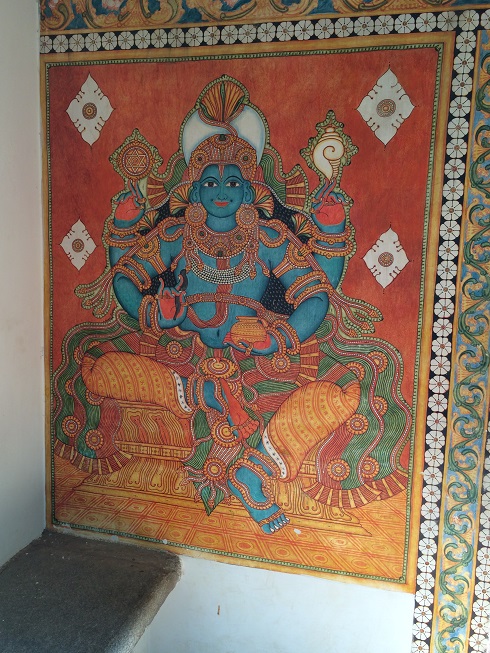
They are so colorful and there are many of them, all different, yet all coordinating.
I was then called for my first two treatments which were abhyañga and śhiro dhārā. More than 2000 years ago in India, oils were found that not only healed illness, but also prevented future imbalances. These therapies were traditionally given (to oneself or to others) on a daily basis. Oil was poured onto the entire body (abhyañga), head (śhiro bhyañga and śhiro dhārā), ears (karna pūrana), feet (pāda bhyañga), or specific sites that required attention (marma bhyañga).
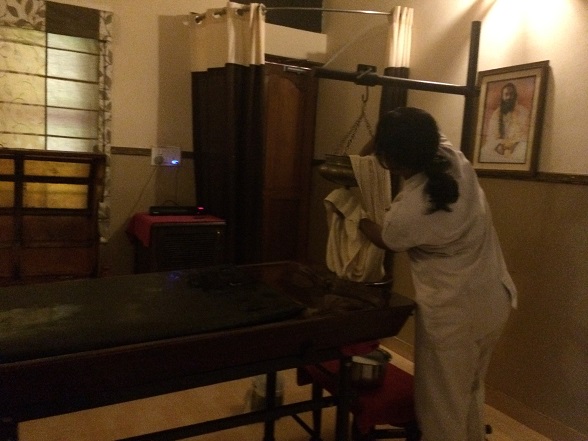
In abhyañga, after the hot oil is poured on your body, it is massaged in a specific pattern. There are many benefits that arise from daily abhyañga. Here are a few:
- Reverse/prevents aging and increases longevity
- Removes fatigue and stress from work and life overall
- Heals and prevents nervous system disorders
- Promotes good vision
- Nourishes the body and promotes sturdiness
- Remedies insomnia
- Creates an electrochemical balance in the body.
- Oil rubbed into the skin prevents dehydration and strengthens the nerves
- Oil helps the electromagnetic field of the body
- Stimulates antibody production, thus strengthening her immune system
After the first treatment is complete, the second treatment, Śhiro Dhārā begins.
Unique to Ayurveda is the hot oil flow on the head. Warm oil poured on the forehead is one of the most divine, relaxing therapies one can experience. ‘Śhiro’ means head and ‘dhārā’ means flow. When people get up from this therapy, a healthy glow radiates form their skin. It is believed that people look 20 years younger, eyes gleam with tranquility, while lips wear a smile of serenity.
Śhiro Dhārā helps with diseases of the head, Prāna Vayu, neck, eyes, ears, nose, throat, and nervous system. It also relieves insomnia, asthma, cholesterol, enlarged prostate, ulcers, rheumatism, etc., and is used to heal difficult diseases like diabetes, schizophrenia, and epilepsy. This therapy has recently been used for attention deficit disease (ADD or ADHD) and also for those suffering from dementia or Alzheimer’s. Various methods of śhiro dhārā exist.
The general method goes something like this: Before the client lays down for the treatment, the practitioner meditates, preparing themselves to be effective healers. Sometimes a prayer is said out loud with the client. The client lies on an abhyanga table or a specially built oil table which drains the excess oil. The oil is held in a quart-sized bowl above the clients head either by the practitioner or by an apparatus. A small hole, a little less than ½ inch, is in the bottom-middle of the bowl (usually copper for cleanliness and heat retention). A spigot might be attached to the bottom of the bowl to more accurately control the oil flow.
A pillow is placed under the clients head and when the client is comfortable, a small stream of oil is allowed to flow from this bowl which is placed about 2-3 inches above the forehead. The oil is applied to one spot on the forehead or in a specific pattern guided by the therapists read of the client’s energy. Clients and practitioner practice mantra meditation during the session to keeps their minds spiritually focused. The traditional approach includes giving the client a short head massage after the oil has been applied.
When the session is over, the client rests for a few minutes on the table. The oil in the hair is pressed into the scalp as its warmth further soothes the client. Then a towel is placed over the head and the practitioner helps the client sit up. The client is given a few minutes to adjust to the seated position before being helped to a standing position. The oil then can be washed out of the hair, or wrapped in a scarf and left in for as many hours as wanted. The entire process takes about 45 minutes to 1 ½ hours.
After finishing this treatment, I don’t know if I look 20 years younger, but I do have that smile!
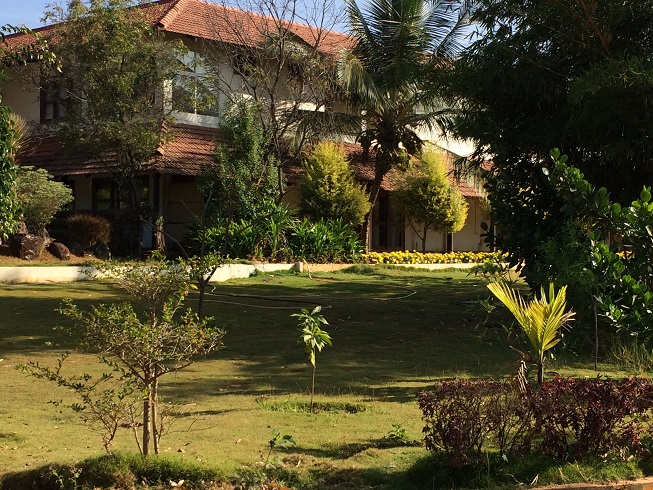
I decided to take a short walk before lunch. The grounds are just beautiful, well cared for, yet wild looking.
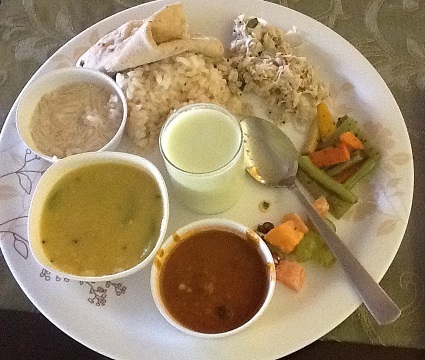
Lunch was quite large (it is the biggest meal of the day!). Not shown was the first course of beet and apple soup. Then on this plate, in the center is buttermilk and then coriander flavored rice and chapatti. Moving clockwise we have theeyal sabji; veggies: green beans, carrots, summer squash, and baby corn; fruit: grapes, mango and pomegranate; masala with okra and curry leaves; kundru dal, and finally my favorite, semiya payasan, a vermicelli pudding.
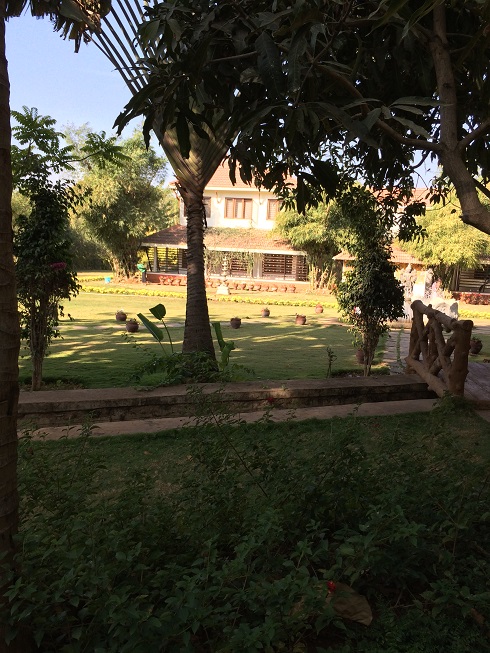
I could only eat about half of that big meal and definitely wanted to digest it before going for my last treatment of the day, marma point massaage.
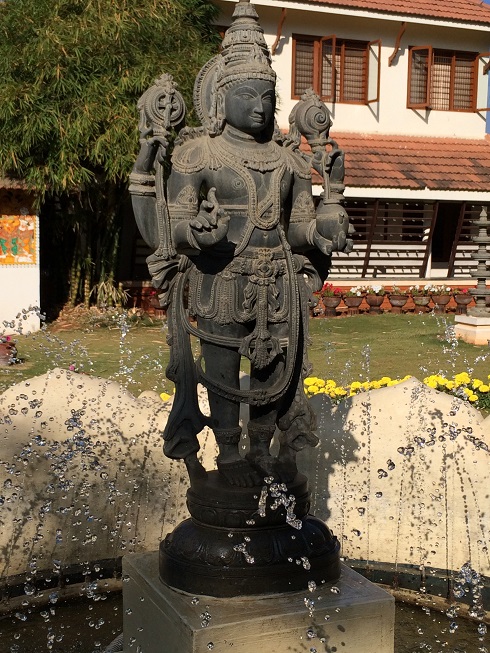
The grounds of this ashram are huge, but very well guarded, so since I was not staying here (I would have been given a giant name tag giving me permission to wander all areas, I decided to stay just in the area of the treatment center. I love this statue of Dhanvantari.
Dhanvantari is an Avatar of Vishnu from the Hindu tradition. He appears in the Vedas and Puranas as the physician of the gods (devas), and the god of Ayurvedic medicine.
Dhanvantari is depicted as Vishnu with four hands, holding Shankh (conch shell), Sudarshan Chakra ( a spinning, disk-like weapon with 108 serrated edges used by the Hindu god Vishnu), Jalouka (Leech) and a pot containing rejuvenating nectar called amrita in another.
It is common practice in Hinduism for worshipers to pray to Dhanvantari seeking his blessings for sound health for themselves and/or others, especially on Dhanteras. Dhanteras is the first day of the five-day Diwali Festival as celebrated in India. During this festival, it is the Goddess Lakshmi that is celebrated for bringing forth wealth and well-being.
In addition, according to another popular legend, on this day, when the Gods and demons churned the ocean for Amrita or nectar, (on the Dhanvantari (the physician of the Gods and an incarnation of Vishnu) emerged carrying a jar of the elixir on the day of Dhanteras.
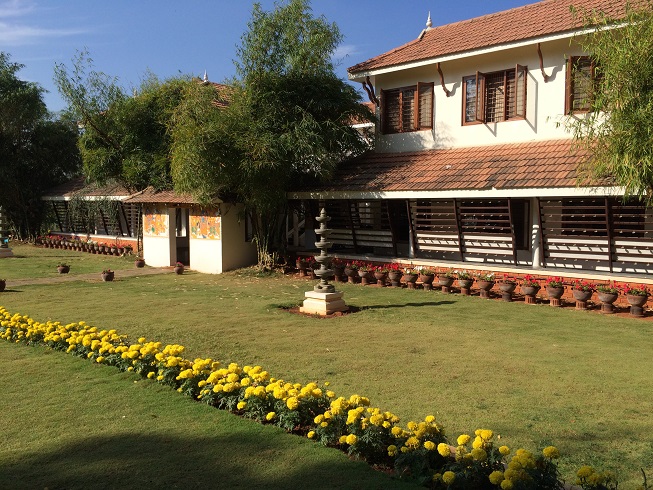
As I strolled through the grounds, it was like doing a walking meditation without doing a walking meditation.
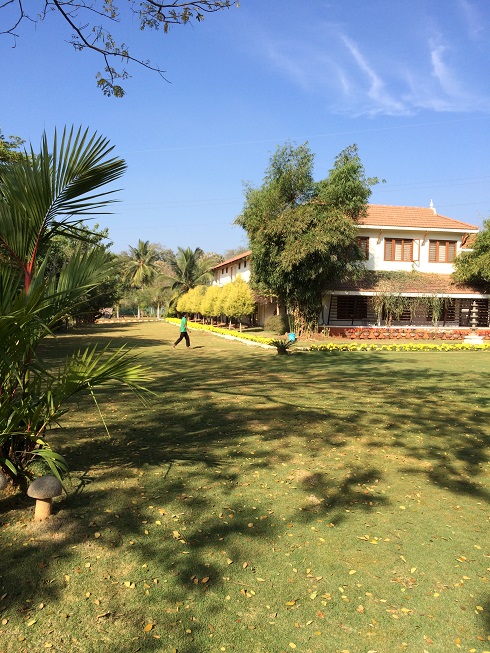
I finished the day with a marma point massage.
The Marmas (vital points) are a very important part of Ayurvedic anatomy and surgery. A marma point is defined as an anatomical site where flesh, veins, arteries, tendons, bones and joints meet up. There are 107 marma points throughout the body. Each point has its own intelligence and consciousness, which co-ordinate with the mind and body. This ancient form of treatment dating back to between 1500 — 1200 BC involves using the fingers to stimulate the Marma points thereby promoting physical and mental rehabilitation. As with Acupuncture, these points correspond to internal organs and systems of the body which react to manual stimulation.
The Sanskrit word Marma, means hidden or secret. By definition, a marma point is a juncture on the body where two or more types of tissue meet, such as muscles, veins, ligaments, bones or joints.
What are marma points? There are total 107 marma in the body. In Tamil traditions they are 108 marma points, and in Kalari tradition there are 365 marma points. The points were mapped out in detail centuries ago in the Sushruta Samhita, a classic Ayurvedic text. Major marma points correspond to the seven chakras, or energy centers of the body, while minor points radiate out along the torso and limbs. The points cover both the front and back body, including 22 on the lower extremities, 22 on the arms, 12 on the chest and stomach, 14 on the back, and 37 on the head and neck. (The mind is considered the 108th marma.) Each has its own Sanskrit name given by Sushruta, one of the founding fathers of Ayurvedic medicine.
The Hindu healthcare system uses marma massage as a routine part of their preventative medicine. A professional therapist isolates the Marma points and cleans them out by increasing the blood flow to the affected part of the neuro-muscular junction. They also aim to tone the surrounding muscles.
The benefits of marma massage are many. The following symptoms are alleviated through marma massage:
o Nervousness & anxiety
o Light headedness
o Numbness or metallic taste in the mouth
o Tingling in the fingertips and toes
o Stress at work & home
o Lack of energy
o Weakness in general
o Muscular aches & pains including back and neck
History of Marma point massage
Marma-point massage dates back to southern India circa 1500 BC. Masters of Kalari, an ancient martial art, first discovered the power of marma points. In battle, Kalari fighters targeted an opponent’s marma points as a way to inflict pain and injury. According to Kalari lore, people have 12 marma points that, when hit with a knockout blow, can cause instant death. These areas were so important that soldiers even used armor to protect their horses’ marma points while riding into battle.
Along with their ability to kill, however, comes an ability to heal. Wounded Kalari fighters were nursed back to health with marma therapy. Practitioners used marma-point massage to stimulate healing in areas that corresponded to the soldier’s injuries. If a warrior suffered a blow to the small intestines, for example, the marma point on the back of the calf, which corresponds directly with the upper intestine, would be massaged to trigger a healing flow of energy to the injury. Eventually, Ayurvedic physicians around India learned of the technique’s powers and brought Kalari masters into hospitals to teach the art. Soon, marma-point training became mandatory for surgeons, who would take great pains to work around specific points lest they risk a patient’s life. Today marma-point massage is still a respected component of Ayurvedic healing.
Marma Massage Today
In summary, simulating or massaging the marma points gives benefits to the area of their locations and improves the function of the connecting organs. The marma massage itself is approximately 60 to 90 minutes of duration followed by steam bath or warm shower. The above is only a brief outline to marma massages. Ideally, marma massages should be first consulted with a qualified ayurvedic physician and performed by experienced therapists. The marma massage can be used as a part of a rejuvenation therapy or it could be used as preventative measure from unwanted conditions. Either way, marma massage is a really useful way to help improve or maintain an individual’s health balance. (www.goaayurvedic.com/Marma)
Then it was time to return to my hotel. The streets were not too busy as “rush hours” had not yet begun. Sometimes one would think that “rush hour” is all day here in Bangalore!
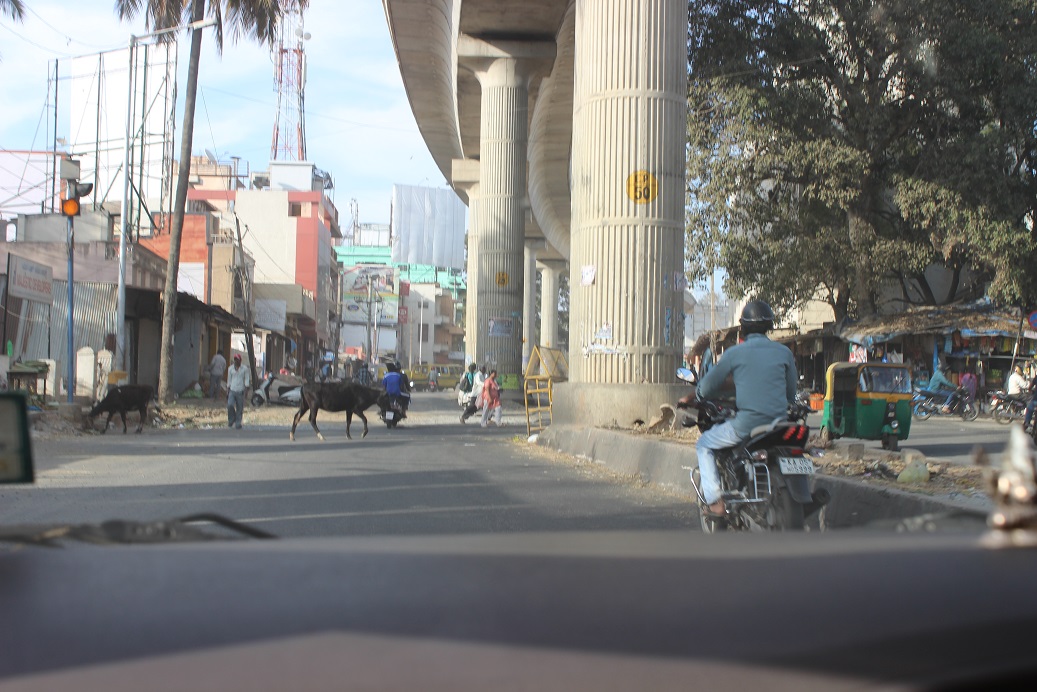
Cows going home from work.
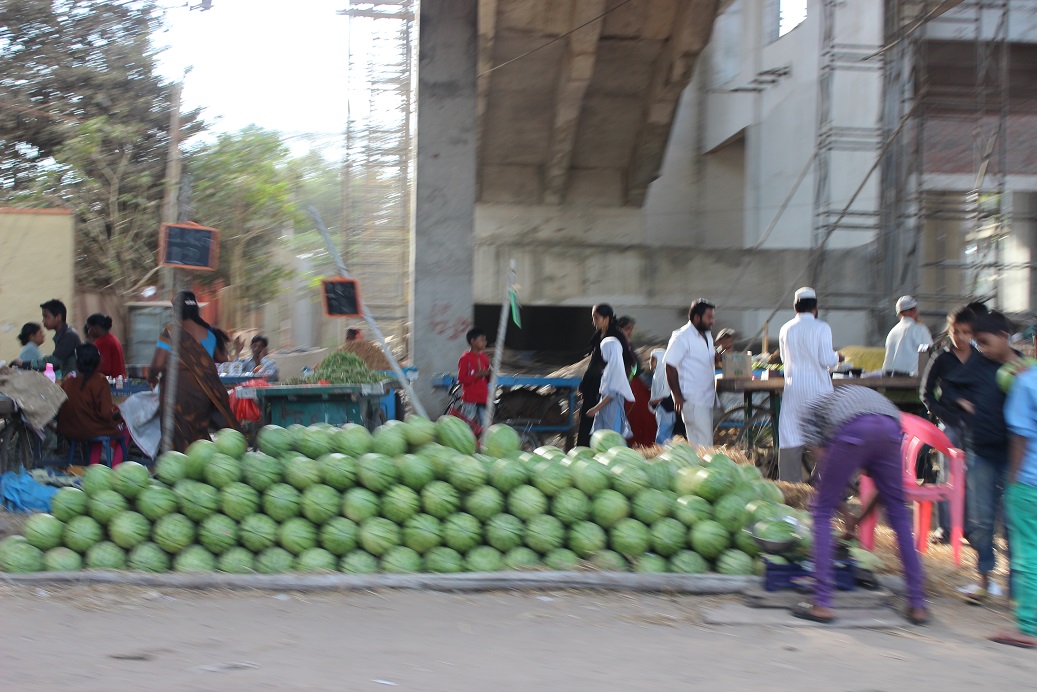
A watermelon vendor is set for the evening rush. I noticed that wherever there were people, there were vendors. So the train and bus stations were prime real estate for setting up food businesses. It got me to thinking how brilliant that was. Thinking about our Dart stations here in town, not too many are right by a grocery store, so the tired travelers have to get in their cars and drive to the store before going home. How about opening a Whole Foods or farmers market right by the Dart stations!

Here’s a guy with cooking pots.

And I asked my driver to stop so that I could take a picture of these grapes…it was amazing how they stacked them up like that.
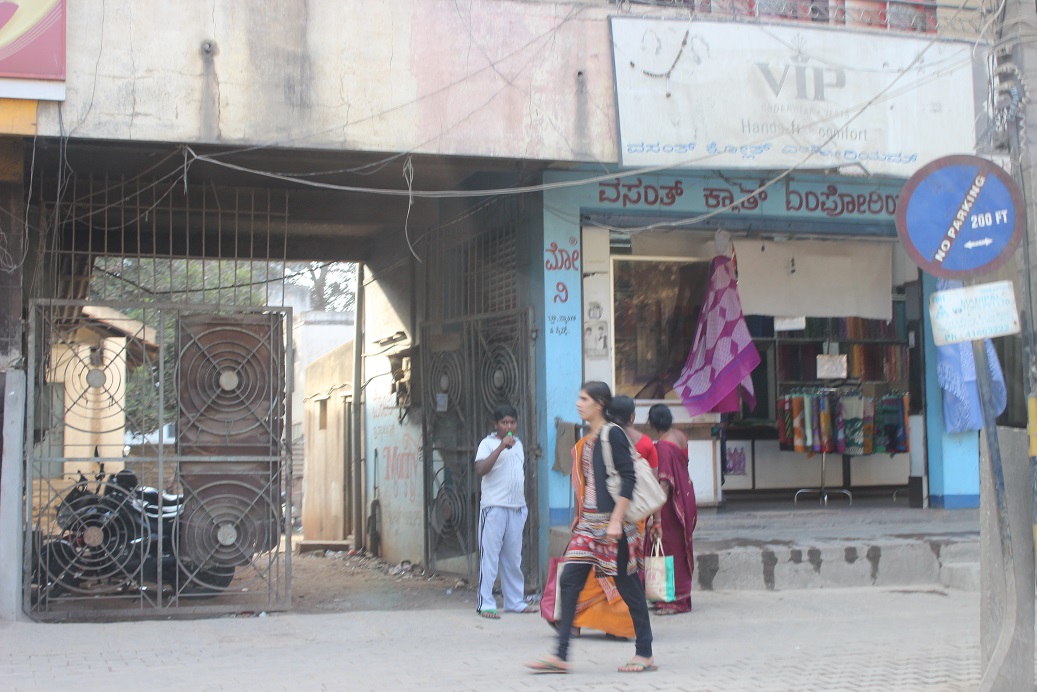
Very cool outfit! Just sayin.
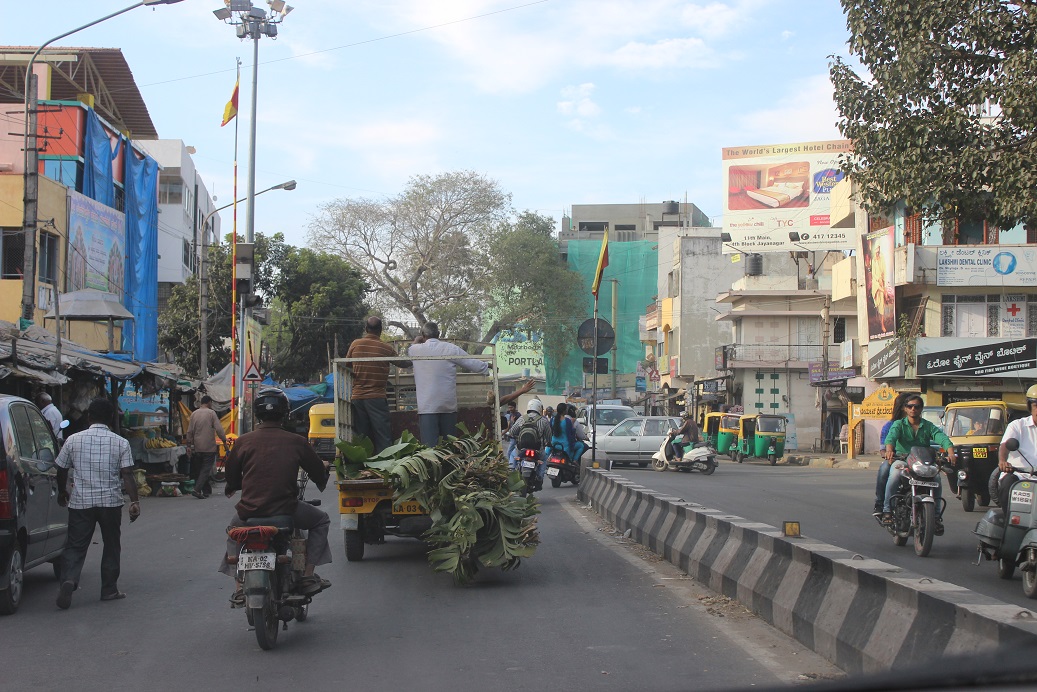
Banana leaves on the way to some restaurants for sure…they use them as plates.
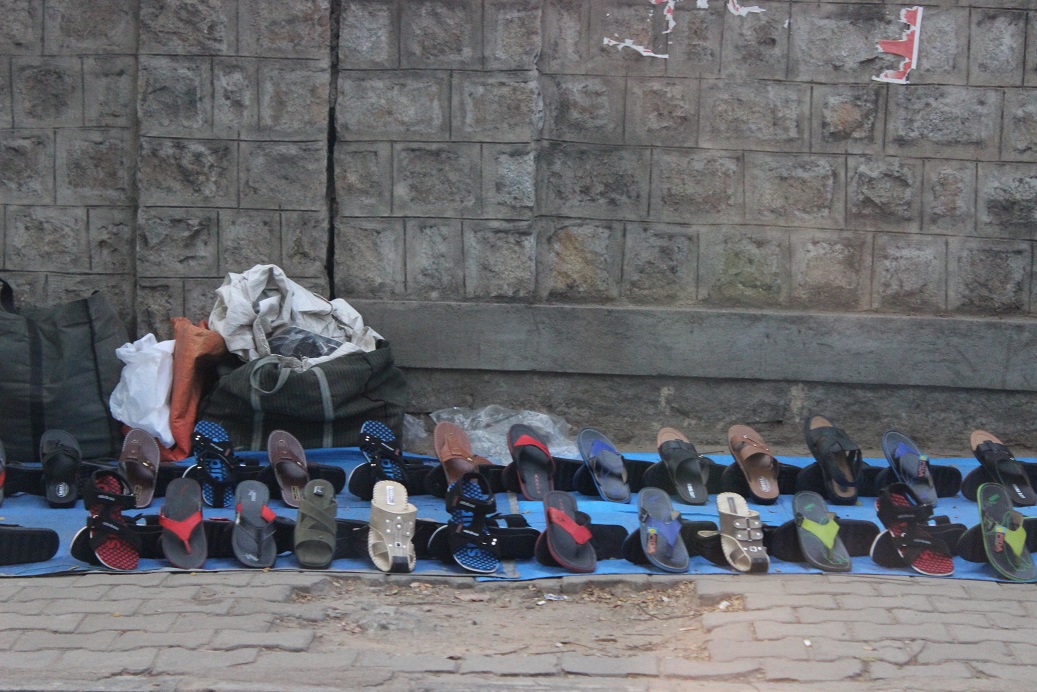
A shoe store.

Oil cans on a bicycle.

Vendor delivering wares on his bike.

Amidst the crazy traffic, this sign “Follow Lane Discipline”. Found this amusing.

As we got closer to the hotel, the shops got invariably more expensive.
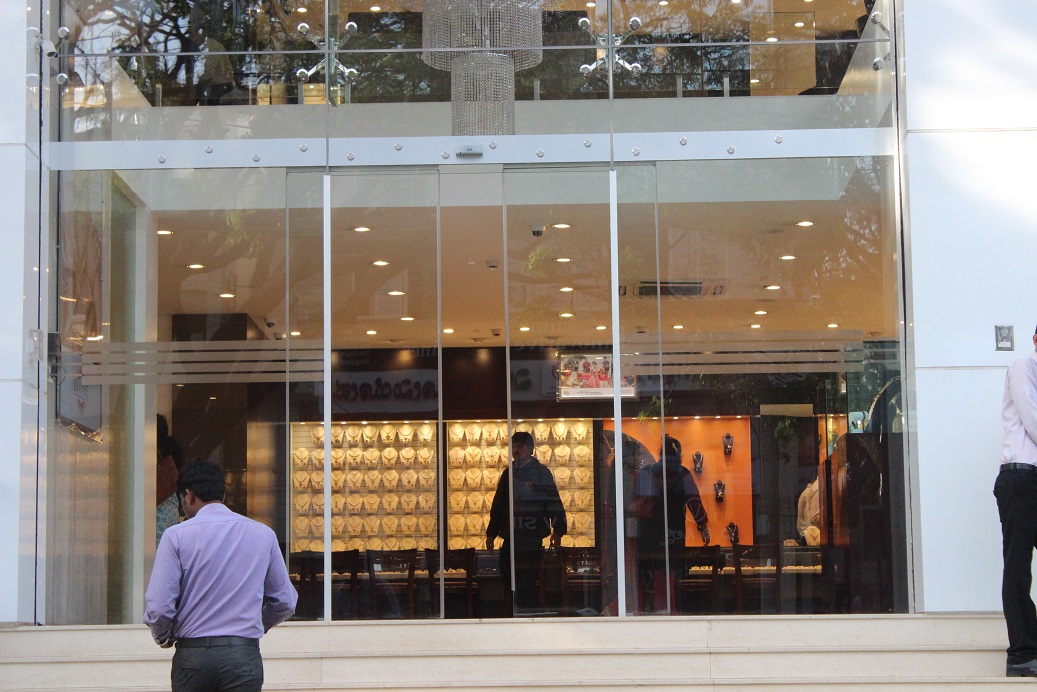
Across the street from the J.W. Marriott was this fine jewelry store.
I was back home for the evening. One more day in India and it was a great one. Tomorrow I am again on my way to Mysore, the home of Ashtanga yoga!
Thanks again for following and sharing my wonderful trip to India. I want to thank my sister Jackie again for editing my blogs. Please share with any of your friends that might find this interesting. Follow me on www.thebalancedyogi.com and facebook.
Blessings,
Peggy
